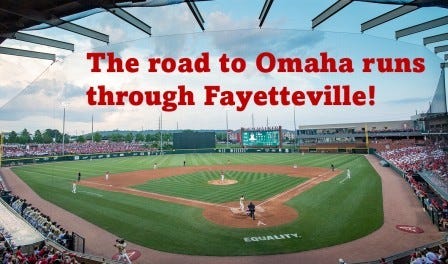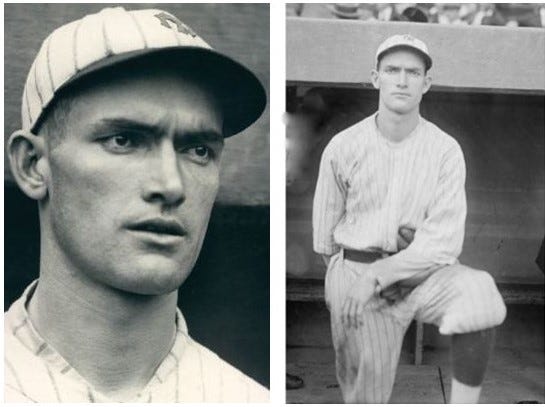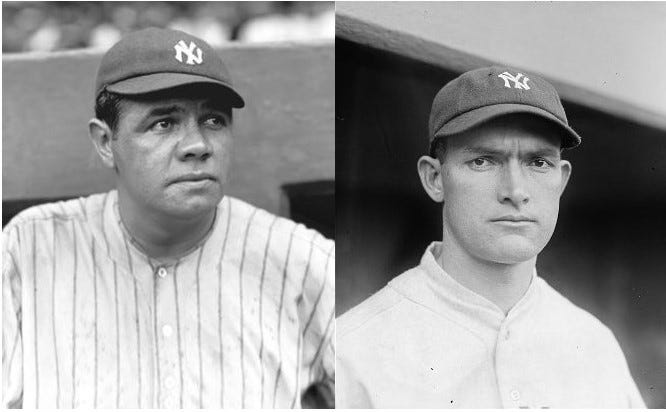Backroads and Ballplayers # 108
Stories of the famous and not-so-famous men and women from a time when baseball was "Arkansas' Game." Backroads and Ballplayers Weekly is always free and short enough to finish in one cup of coffee.
The Thrill of Victory and the Agony of Defeat Mean More in the SEC
To steal a line from Andy Williams’ Christmas classic “It’s the Most Wonderful Time of the Year,” to follow college baseball, unless you are a fan of Vanderbilt, Texas, Georgia, Alabama, Florida, Kentucky, or Mississippi State. Of the 13 SEC teams that played in the NCAA Regional round, more have been eliminated than remain.
We Razorback fans have been there. High expectations lead to the most depressing letdowns. A year ago on this date, Southeast Missouri State eliminated the Razorbacks at Baum-Walker.
This year, the Hogs breezed through their home regional, but if Tennessee prevails in Knoxville, the Super Regional in Fayetteville will be a historic event featuring excruciating pain or temporary celebration.
I coached for fifteen years. Because of the dedication and talent of good players, my teams won dozens of significant championships. Each of those teams lost its last meaningful game. Every team that remains alive in the NCAA tournament, except the one that builds a dog pile on the mound at Omaha, will also lose its most important game.
Tonight, as you read this, Oklahoma, Ole Miss, Tennessee, and LSU are one bad game away from despair. Of the 13 SEC teams on the original bracket, only Arkansas and Auburn are home tonight watching TV with a smile.
The UA Little Rock Trojans’ Amazing Run
I had planned to hold this week’s Backroads and Ballplayers Weekly until tonight’s games were finished, but I honestly cannot wait to congratulate the Little Rock Trojans for a remarkable run. I am somewhat ashamed to say that I was surprised when they came back from three down to bury LSU 10-4.
I have been hearing Chris Curry’s name for several years. He was on my list of Arkansas-born guys (Little Rock) who declined the draft to stay in college baseball. Curry finished his college career at Mississippi State. After being selected for the fourth time in the MLB Draft in the spring of 1999, he was drafted in the ninth round and finally signed by the Cubs.
He was an assistant coach at Arkansas Tech in 2008, and he was an assistant to Dave Van Horn in 2009 and 2010.
What kind of individual could keep a team focused on a positive goal after a losing season marred by two lengthy losing streaks? The answer is a great motivator and a remarkable coach. I plan to make the Chris Curry story a feature next Monday.
Tennessee vs. Wake Forest - 5:00 PM
UA Little Rock vs. LSU - 8:00 PM
________________________
A Subscription sends these weekly posts to your mailbox. There is no charge for the subscription or the Backroads and Ballplayers Weekly.
If you do not wish to subscribe, you will find the weekly posts on Monday evenings at Backroads and Ballplayers on Facebook. SAVE THE LINK…
__________________________
The Best of the Lost Part II
When asked to list the best Arkansas-born player who had been overlooked in Arkansas’ baseball history, I chose four guys from the first half of the 20th century. Smead Jolley, Earl Smith, Aaron Ward, and Jimmy Zinn all reached the major leagues and accomplished some remarkable things as professionals, but none of the four have been chosen as members of the Arkansas Sports Hall of Fame.
I plan to highlight one year in each of their careers.
Piggy and the Babe - Aaron Ward, 1923
Back in Franklin County, we would have characterized Aaron Ward’s qualifications as a major league baseball prospect in the early 1920s with a phrase commonly used to describe those who had wandered into situations where they did not belong. Aaron Ward had no business in big league baseball.
The Travelers had signed him off a semi-pro team in the last few weeks of the 1915 season. He wasn’t expected to hit, and he did not. Ward was hitless in 18 at-bats. After two games the next season, when he was one for seven, and Little Rock optioned him down to Montgomery, a couple of levels lower in the minors, where he hit .268 with very little power.
In a time when every player seemed to be given a nickname based on some personality trait or some unique feature of his appearance, early in his minor-league career, Ward became “Piggy.”
Although he came out of Ouachita at about 5’9” and less than 150 lbs, Ward inherited the nickname of a rotund Southern Association veteran named “Piggy Ward. Piggy Ward was humorous, colorful, and well-liked. In his absence, Aaron Ward became another “Piggy Ward.”
After another lackluster year in the minors in 1917, the desperate New York Yankees signed Ward to a big-league contract. One sportswriter back in Little Rock reviewed the Yanks’ new reserve with a colorful description: “He was a pretty good infielder, but he couldn’t hit a lick!”
Ward proved his Little Rock review to be accurate. Because he could fill in at almost any position, New York kept him on the roster. Ward played eight games in 1917 and batted .115. He played 20 games in 1918 with a .125 batting mark, and 27 games in 1919 and a .206 average.
By 1920, the veterans were returning from military service, and it looked like Ward’s big-league days were numbered. Surprisingly, 1920 would be a pivotal year for Ward and a dramatic turning point in the history of the New York Yankees.
The day after Christmas 1919, became the most memorable non-game day in the history of the New York Yankees franchise. On that day, the Yankees purchased the services of George Herman Ruth from the Boston Red Sox for $100,000. The extraordinary bargain would lead to legendary success for the Yankees and a run of bad luck in Boston so inexplicable that Red Sox fans declared it to be a curse.
For Aaron Ward, February 12, 1920, would be the day his career took another fortunate turn as a result of a tragic event. On that date, venerable Yankees third baseman Frank “Home Run” Baker’s 31-year-old wife died of pneumonia at her home in Pennsylvania. The loss left two small children in Baker’s care and ultimately became a crisis for the New York Yankees. The future Hall of Famer announced a few days later that he would not return to the Yankees but would devote his time to the care of his daughters.
Baker stayed true to his word, and after a few weeks of experimenting with various combinations, the 1920 Yankees settled on a new right fielder by choice and a new third baseman by elimination. The somewhat desperate Yankees tested several candidates at third in early April, eventually giving Ward the job amid obvious skepticism. He would soon turn that doubt into cautious optimism.
In the first three months of the season, Ward met only the Yankees’ modest expectations. He produced mostly singles at the plate, and, despite his history as a middle infielder, Ward handled the unfamiliar hot corner well enough. The Yanks anticipated a temporary caretaker for Home Run Baker’s position, and a light-hitting glove man would have to do.
Fortunately for Ward, by mid-season, he seemed to adopt a more aggressive hitting strategy that he may have learned by observing his new teammate, Babe Ruth. In the last half of the season, Ward more than doubled his extra-base hits, including nine home runs. His 11 homers for the season would tie for second on the team and seventh in the American League. Babe Ruth hit an incredible 54 home runs, more than the total for the combined roster of any team in the American League.
The Yanks’ emergency player had found a permanent place. “Aaron Ward of the Yankees hits a ball as hard as any young player in many a day. He is a swinger from the end of his bat, and he belts them far and swiftly.”
Home Run Baker returned in 1921, and, while Baker reclaimed his old position at third, the Yankees traded well-respected second baseman Del Pratt to Boston. The deal would bring future Hall-of-Famer Waite Hoyt to New York and open second base for Aaron Ward. Ward no longer needed to look at the card posted in the dugout to see if he was in the lineup. He led the team in games played and raised his batting average to an improbable .306. More in line with expectations, his defense was outstanding. Despite playing a few games at third to relieve Baker, Ward was third among the league’s second sackers in assists and third in fielding percentage.
Ward's hitting fell off in 1922, but he continued to lead the team in games played. His .267 batting average was more than acceptable, considering he was one of the league's premier defensive infielders. He led all American League second basemen in assists and was second in fielding percentage.
The 1923 season would be Aaron Ward’s best season and a historic summer in the history of the New York Yankees. The team that had been playing in the shadows of their landlords, the Giants, would open the season in their new home, Yankee Stadium, and become the Bronx Bombers.
Yankee Stadium opened on April 18, with an announced attendance of 74,000 and another 25,000 left outside. In the home half of the third inning, the fans got what they came for. A 26-year-old second baseman from Booneville, Arkansas, hit a sharp single between short and third for the first hit by a Yankee in the new stadium. Later in the inning, right on script, Ruth hit the first home run in the new park. Ward got a box of cigars for his inaugural hit, and the Yankees started the season with a 4–1 victory in what would become the year the New York Yankees began the ascension to legendary status.
The Yanks coasted to the American League pennant by 16 games, and “Glove Man” Aaron Ward was now a complete player. Hitting in the middle of the Yankees lineup, Ward hit a solid .284, drove in 81 runs, and was second on the team to Ruth in homers and triples. He led the league’s second basemen in fielding percentage and assists. Manager Miller Huggins proclaimed, "He is a real ballplayer, one of the best in either league."
New York's American League team capped the year by defeating their arch-rivals, the Giants, four games to two in the 1923 World Series. It was the third consecutive year the bitter rivals had met in the Fall Classic and the first championship for the Yanks. In the previous two meetings, Aaron Ward had made the final out in the series—in 1921 on a base-running blunder and in 1922 on a harmless fly to right field. His combined batting average for both the postseason matchups with the Giants was .205. In 1923, Ward led World Series hitters with 10 hits and a .417 batting average. He handled 38 chances in the field without an error, including the last out—a weak ground ball to second base.
It would be Aaron Ward’s finest hour, but his career would go into a rapid decline that saw him lose his position in the Yankees’ infield, be traded to the Cleveland Indians in 1928, and be back in Little Rock for part of 1929.
Despite his stardom in the early 1920s, Aaron Ward’s place in baseball history is largely overlooked. His accomplishments were soon eclipsed by the Yankees who followed him, and the arrival of charismatic stars like Lou Gehrig and Tony Lazzeri left Ward somewhat forgotten in New York.
Perhaps more lamentable and difficult to explain is that Arkansas’ first major league star has yet to be inducted into the Ouachita Baptist University Hall of Fame or the Arkansas Sports Hall of Fame.
More thoughts on Reinstatements and Children of the Corn
The discussion resulting from the commissioner’s “pardon” of the players who were suspended “for life” is still ongoing. In case you missed it, I wrote about Arkansas Native Gene Paulette in an earlier Backroads and Ballplayers Weekly. LINK to Backroads and Ballplayers Weekly #106
On Sunday, the Arkansas Democrat-Gazette’s Philip Martin revisited the movies that featured the 1919 Chicago Black Sox. Martin is an award-winning columnist who usually writes about movies, pop culture, and history, but he is an outstanding baseball writer. His Children of the Corn that ran in Sunday’s Arkansas Democrat-Gazette is a reexamination of Eight Men Out and Field of Dreams. It is linked below.
LINK Children of the Corn, Philip Martin
___________________
More Arkansas baseball history and book ordering information: Link
Welcome, new subscribers. Have you missed some posts? Link







